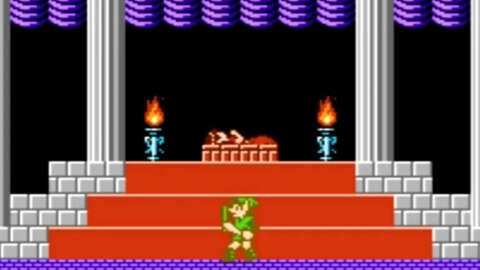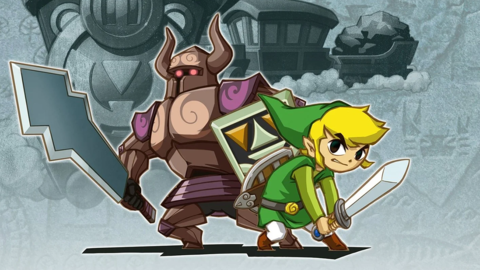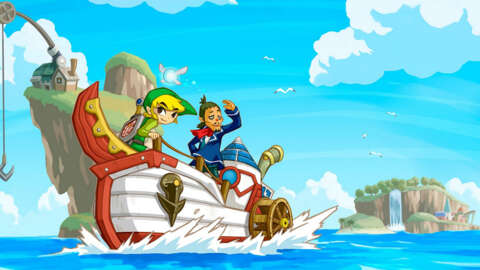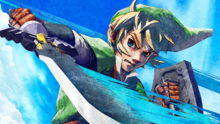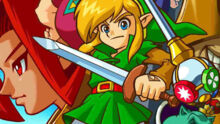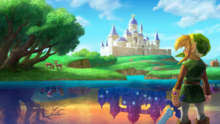The Legend of Zelda: The Wind Waker is celebrating its 20-year anniversary today, March 24, 2022. Below, we examine how some of its rough edges served as an unexpected precursor to Breath of the Wild.
The Legend of Zelda: The Wind Waker is usually ranked among the most beloved entries in the series, alongside era-defining classics like Ocarina of Time and Link to the Past. That said, when viewed from a more distant perspective, Wind Waker is perhaps the most obviously unfinished game to ever wear the legendary name. That's not necessarily a bad thing, as its flaws--most notably its infamous Triforce hunt--prefigured many of the same qualities that would define later entries, especially Breath of the Wild.
From the very start, Zelda games have always featured exploration as a key element--even finding the dungeons in the original '86 entry can prove challenging for newcomers. However, while delving into every corner of the overworld can grant you many useful goodies (like Pieces of Heart) in '90s Zeldas such as Link to the Past, you rarely have to wander around to figure out where to go next. Modern Zelda games often signpost you from location to location in a fairly clear fashion. The same is true of Wind Waker, but there's very much a point where that guiding line fades away.
Generally considered one of the easier Zelda games, Wind Waker makes a special point of holding the player's hand through its first few dungeons, arguably right up to its halfway mark. Once you beat the Tower of the Gods and collect the Master Sword, the game world fully opens up, allowing you to traverse the waters of the Great Sea for loot and Pieces of Heart. However, if you're the kind of player who beelines from dungeon to dungeon without much regard for upgrades, you're in for a rude awakening at the end of Wind Waker's last traditional dungeon, the Wind Temple. You need the Triforce of Courage to enter Hyrule to face Ganon once and for all, and it's been split up into eight shards, scattered all across the islands.
Zenless Zone Zero - Yixuan Character Demo | "Martial Summit Showdown" Yakuza 0 Director’s Cut – Opening Movie Trailer | Nintendo Switch 2 Hell Is Us' Intriguingly Bold Design Decisions Refuse To Give You A Hint Elden Ring Nightreign GameSpot Video Review GeForce NOW | Supercharge Your Steam Deck Trailer Super Mario Party Jamboree – Nintendo Switch 2 Edition Overview Trailer Anno 117: Pax Romana - Gameplay Trailer EA Sports College Football 26 Official Reveal Trailer ELDEN RING NIGHTREIGN | Bring Me to Life - Evanescence | AMV Trailer Nintendo Switch 2 - Nintendo Switch Online Overview Trailer Switch 2 Mouse Controls Make This The Definitive Version of Kunitsu-Gami The Division 2: Battle for Brooklyn DLC - Launch Trailer
Please enter your date of birth to view this video
By clicking 'enter', you agree to GameSpot's
Terms of Use and Privacy Policy
I first played Wind Waker when I was 10 years old. As a dumb kid with limited patience, I really struggled with the Triforce hunt--I simply couldn't figure out where to go or what to do to progress. In Wind Waker's defense, the game mails you a map marked with all of the Triforce chart locations--though if you're anything like me, you likely forgot about the red mailboxes entirely. The process of getting these charts isn't always obvious--shout-out to those who remember the elusive Ghost Ship--and once you collect them all, you have to return to Tingle and pay a hefty fee of 3184 rupees to translate them. With these steps completed, you still have to sail around to find the shards out in the world.
Regardless of how you feel about Wind Waker's Triforce hunt, I think it's fair to say that there was room for improvement in the GameCube original. Nintendo would seem to agree with this, as the developer reduced Tingle's translation fee, as well as the number of Triforce Charts from eight to three, in the Wii U remaster in an attempt to reduce the quest's tedium. This revision was largely successful. (The other five chart locations became the shards themselves.) There were certainly problems with the execution, but the design impetus behind the Triforce quest was ultimately a good one--Nintendo wanted to give you a reason to explore Wind Waker's islands beyond just the usual power-ups, which is why it costs so much money to translate the charts in the first place.
But there's another reason that the Triforce hunt became such an important part of Wind Waker's back half: Nintendo cut two dungeons from the game, perhaps due to limited development time. Longtime Zelda producer Eiji Aonuma acknowledged the cuts an interview with Eurogamer in 2013, where he also confirmed that those dungeon concepts were used in later Zelda games. The details of what form these dungeons were planned to take are disputed by many, but when you read about Wind Waker's cut content, it becomes clear that the game was intended to be far closer to Ocarina of Time than the final product.
For example, Link obtains Nayru's Pearl after a conversation with the whale Jabun, unlike the other two pearls, which require the player to complete dungeons before you can obtain them. Jabun himself is an obvious reference to the fishy wonder Jabu-Jabu from Ocarina of Time, who serves as the third dungeon in that game, so it would logically follow that there was a plan for a dungeon at Greatfish Island before it was cut. That's just speculation, of course.
Though we'll probably never know the exact nature of Wind Waker's cut dungeons, it forced Nintendo to double down on the game's impressive array of islands to carry its hour-count. The double-work of finding charts to find shards was not the ideal implementation, but it did force players to engage with every facet of a Zelda world like no entry since the 1986 original. And this focus on world design over pure dungeoneering presaged the approach that Breath of the Wild would take years later.
Wind Waker's key mapping mechanic, which requires players to feed a talkative fish in exchange for a filled-out map square, anticipated the Ubisoft tower-climbs that would serve as the backbone of the open-world genre for decades to come. And though modern players might find the game's world to be a bit small and sparse by today's standards, I would argue that the game lacks much of the filler that can sink today's open worlds at times. Like Breath of the Wild after it, each of Wind Waker's islands has a fun puzzle to solve or challenge to tackle, and it rarely (if ever) feels like a waste of time to fully explore each map square.
While Wind Waker will always remain just a tiny bit outside the true top echelon of Zelda games, it deserves more recognition as one of the most important games in the series. Its renewed focus on exploration would lead to the more vibrant areas of Twilight Princess and Skyward Sword, and ultimately the true open-world experimentation of Breath of the Wild. The Triforce quest may remain one of the more maligned aspects of any game in the series, even after the Wii U changes. Still, something great came out of Wind Waker's biggest flaw, and that's ultimately what matters.

